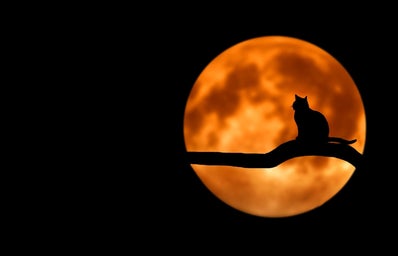*Possible spoilers for Practical Magic and The Craft
*Trigger Warning for mention of DV
With Halloween right around the corner, I have been rewatching my favorite spooky movies. Sometimes I watch scary movies (which I always regret), but my true favorites are movies like Practical Magic and The Craft. Both movies were made in the 90s and at the core of the stories are female liberation– plus a little magic. This year in particular I began to notice these feminist themes. It prompted me to wonder what it was about feminism during this time that caused it to utilize stories of witches and magic to express the fight for women’s equality.
Historians tend to divide feminism into four different waves. The feminism occurring during the 90s was labeled as the “third wave” and emphasized, “tackling problems that still existed, including sexual harassment in the workplace and a shortage of women in positions of power” (Pruitt 2023). These issues seeped into all aspects of life and movies like Practical Magic and The Craft tackled these problems through the lens of witchcraft. In these stories being a witch and wielding magic allows these women to tap into their power and fight against sexism and misogyny.
In Practical Magic made in 1998, we meet sisters Sally and Gillian, played by Sandra Bullock and Nicole Kidman. Being born into a magical family affects both girls very differently. Sally opts to lead a normal life and hardly utilizes magic. Gillian, on the other hand, is more adventurous and leads a life of risk. The sisters become estranged as their lives take different paths, and Sally’s takes a tragic turn after her husband is killed. In the midst of her grief, she receives an urgent plea from her sister to come get her. Once they reunite it is revealed that Gillian has become a victim of domestic violence. Her boyfriend is abusive and in order to escape his abuse she laces his drink with a magical potion. Unfortunately, he finds the girls before they reach home and holds them hostage. He becomes violent toward Gillian and they end up killing him. The movie then follows the sisters as they cast a forbidden spell to reincarnate him in order to clear their names. As the sisters deal with the consequences of the spell the movie tells a tale of their resilience in the face of tremendous grief, mistakes, and anger. As much as Practical Magic is considered a cozy, Halloween classic, it has much deeper meaning. It celebrates fierce female independence and the strength it takes to heal, forgive and accept your true self. It is not until both women do this that they are able to be authentic and confident. The film ends with Sally, her daughters, Gillian, and their Aunts proudly donning their witch regalia, brooms, and hats included. Sally is no longer crushed under her grief and Gillian has stood up to her abuser. Each woman is in possession of her identity and has claimed her power.
The Craft (1996) focuses on a group of high school girls who are treated as outcasts. When new girl “Sarah” arrives in town, the group takes her under their wing and it is revealed that they are a coven of witches. The girls become best friends and protect each other from bullies as well as their own inner turmoil. The Craft does an excellent job of capturing the angst and frustration that comes along with being a teenage girl, as well as the power of female companionship. An important facet of feminism is the value of lifting other women up even if they are different from you. All of the girls in The Craft are different from one another, but that does not stop them from being friends and protecting each other. Where The Craft differs from Practical Magic is its use of anger as a tool for feminists. As the coven grows stronger, so does the girl’s confidence and they are able to stand up to the men who slut-shame and objectify them. The girls in The Craft are angry and not afraid to show it. Third-wave feminism utilized anger in a clearer way than prior eras of the movement had. Third-wave feminists rejected “nice” girls and “good” girls and questioned these boxes. One popular aspect of third-wave feminism were girl punk bands dubbed “riot girls”. The Craft embodied riot girl spirit through the fashion and styling of the characters. The coven dressed for themselves and not the patriarchy. The girls were not just distraught or sad when a boy harassed them, they were angry and they showed it.
So why did storytellers in the 90s want to express feminism through stories of witches? During the 1990s third-wave feminism was informed by major events like the Capitol Hill hearings where Anita Hill testified against now Supreme Court Justice Clarence Thomas for sexually harassing her while she was his aide. These hearings soon became all too similar to the actual Salem witch trials that occurred centuries before. At one point during the trial, a senator accused Ms. Hill of lying about her experiences and said she was using a story from The Exorcist and that she was crazy. The hearings triggered outcry from women. After Anita Hill’s testimony in 1991 came “The Year of the Woman”. In 1992, twenty-seven women were elected to Congress, which was a record number at the time. The 90s were a time of great strides for women’s equality. Practical Magic and The Craft used the mythology of witches to exemplify this power.
For many, “witch” has a negative connotation. Movies like The Craft and Practical Magic reclaimed the definition of witch. These movies made witches feminist figures and celebrated female power. They became role models in the same way superheroes had traditionally been for boys. Witches were mystical and larger than life. Both movies were a platform for female independence. The women in these movies stood up for themselves. They were portrayed as multifaceted beings with flaws and strengths. The first time I saw Practical Magic I wanted to be one of the Owens Sisters. The first time I saw The Craft I was empowered by their uninhibited rejection of being “good girls”. The mystery of magic and spells surrounding witches will always be alluring. However, movies like Practical Magic and The Craft used stories of witches to empower women and show them that true magic lies in being confidently yourself.


